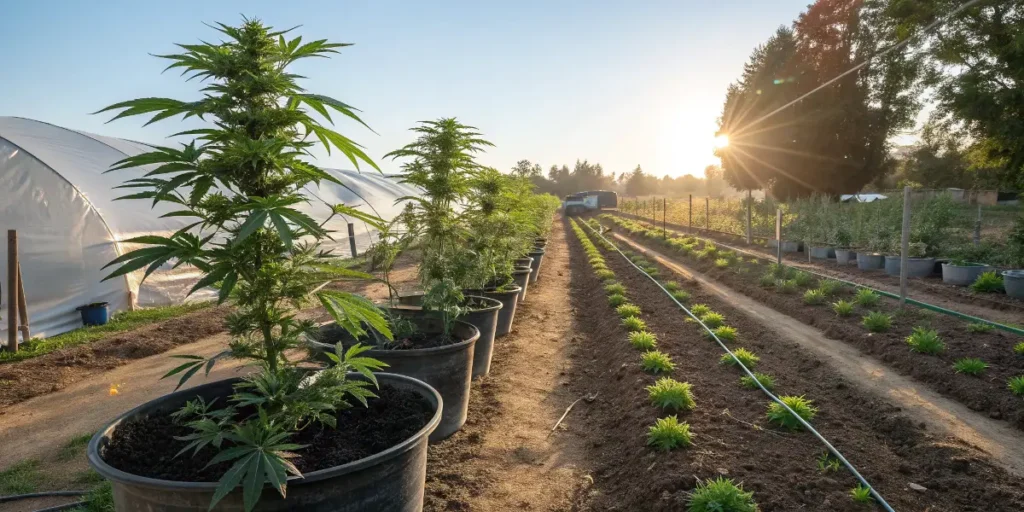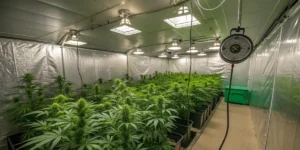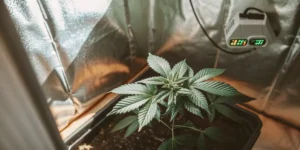Growing Watermelon Auto, an autoflowering cannabis strain, offers cultivators the benefit of an expedited growth cycle without the need for strict light schedules. Like other automatic varieties, this plant switches from vegetative growth to flowering automatically after a certain period of time, usually between 3 to 4 weeks. This characteristic makes it an excellent choice for beginners and those looking for a quick turnaround. With its fruity aroma and compact size, Watermelon Auto can thrive both indoors and outdoors, allowing for flexibility in growing environments.
The first step in cultivating Watermelon Auto is to choose the right growing medium. It performs well in soil, coco coir, or hydroponic systems. Soil is recommended for novices due to its forgiving nature and inherent nutrient content. Ensure the soil is light and airy, with good drainage, to promote healthy root development. Alternatively, coco coir provides excellent water retention and aeration, while hydroponics offer speedier growth and better nutrient control.
Once you have selected a medium, it’s crucial to maintain the appropriate environmental conditions. This strain prefers a warm temperature range between 70°F and 85°F (21°C to 29°C) and relative humidity levels around 50% to 70% during vegetative growth, lowering to 40% to 50% during flowering. Proper ventilation is essential to prevent mold and pests, particularly in indoor setups, so employing fans or an exhaust system can improve air circulation effectively.
When it comes to feeding, Watermelon Auto demands a balanced diet of cannabis-specific nutrients. During its early vegetative stage, utilize a nutrient solution high in nitrogen to promote strong growth. As the plant transitions to flowering, reduce nitrogen levels and increase phosphorus and potassium to encourage bud development. Be cautious with overfeeding, as autoflowering plants are generally more sensitive to nutrient concentrations than photoperiod strains.
Watering should be thorough but not too frequent. Allow the top inch of the growing medium to dry out between waterings to prevent waterlogged roots, which can lead to root rot. If using a hydroponic setup, monitor the pH closely, maintaining a range between 5.5 and 6.5 for optimal nutrient uptake. Periodically checking the electrical conductivity (EC) of your nutrient solution can also help ensure your plants receive adequate nutrition without over-salting the root zone.
As an autoflowering plant, Watermelon Auto will naturally start to flower after around three to four weeks without needing a shift in light periods. This simplicity is advantageous for beginners who might be unfamiliar with managing light schedules. The entire lifecycle of Watermelon Auto, from seed to harvest, typically spans approximately 8 to 10 weeks. Harvest your plants when the trichomes have turned milky white, with about 10% turning amber, signaling peak potency. A proper flush two weeks before harvest will ensure a cleaner, smoother taste in the final product.
Watermelon Auto Strain Overview: Traits, Effects & Genetics
Watermelon Auto is a captivating autoflowering strain that has gained popularity among growers for its remarkable traits and delightful effects. This strain is characterized by its ability to transition from the vegetative stage to flowering automatically, without the need for a change in the light cycle. This makes this variety an excellent choice for both novice and experienced cultivators looking for a fuss-free growing experience. Its compact and resilient nature, along with a relatively short life cycle of approximately 8–9 weeks from seed to harvest, makes it an attractive option for indoor and outdoor growing setups.
What sets the cultivar apart is its distinctive aroma and flavor profile, reminiscent of fresh watermelon with subtle fruity undertones. This, combined with its vivid appearance featuring lush green leaves and dense, glistening buds covered in trichomes makes it a sensory delight. The plant typically showcases a balanced indica-sativa genetic composition, which translates into a harmonious growth pattern and well-rounded effects. This versatility is paired with a moderate THC content that appeals to recreational users without overwhelming them, reinforcing its broad appeal.
In terms of effects, Watermelon Auto is renowned for inducing a soothing and uplifting high that is ideal for relaxation and stress relief. The strain offers users a gentle cerebral buzz that melts into a calming body relaxation, striking an immaculate balance between mental and physical effects. This makes it ideal for unwinding after a long day or enjoying leisurely social gatherings. Its calming qualities can also aid in mitigating mild stress and anxiety, promoting a sense of well-being and contentment.
The genetics of this strain are rooted in a clever cross-breeding of select varieties that combine the best of both indica and sativa traits. Its lineage often includes influences from the classic Watermelon strain, infused with ruderalis to ensure its autoflowering nature. The result is a robust plant that thrives even under less-than-ideal conditions, making it a favored choice for growers seeking reliability and productivity. The careful breeding ensures a consistent growth pattern, potent effects, and a delightful flavor, making Watermelon Auto a prized addition to any cannabis enthusiast’s collection.
Optimal Environment to Grow Watermelon Auto Successfully
When cultivating Watermelon Auto, an autoflowering cannabis strain renowned for its succulent flavor and high yield, creating an optimal growing environment is paramount. This strain thrives in both indoor and outdoor settings, but the environmental conditions will significantly influence the quality and quantity of your harvest. Starting with light requirements, this variety benefits from 18-20 hours of light each day during its lifecycle. For indoor cultivation, full-spectrum LED grow lights are recommended to mimic natural sunlight and ensure robust plant growth.
Temperature consistency is vital for Watermelon Auto. The ideal temperature range during the vegetative stage is between 70–80°F (21–27°C), ensuring the plant grows rapidly and robustly. During the flowering stage, a slight drop to approximately 68–75°F (20–24°C) can encourage resin production. Maintaining this temperature range can help prevent plant stress or disease. Additionally, controlling humidity levels is crucial; aim for 40–60% during the vegetative stage and taper it down to 30–40% during flowering to prevent mold and mildew in the dense buds.
Air circulation and ventilation are also essential components of a perfect growing environment. A gentle yet consistent breeze helps strengthen stems and ensures uniform temperature and humidity throughout the growing area. When cultivating indoors, using oscillating fans can promote air movement and prevent stale pockets of air. Implement a quality ventilation system with a carbon filter to manage odors and refresh air suppleness, further supporting plant health and vigor.
For soil or hydro setups, proper pH balance and nutrient supply ensure vibrant growth. In soil, maintain a pH between 6.0-7.0, while hydroponic growers should aim for a pH of 5.5-6.5. Employ organic or mineral-based nutrients designed for flowering and vegetative stages. The strain requires balanced levels of nitrogen, phosphorus, and potassium, with micronutrients to boost its flowering potential. Monitoring and adjusting nutrient doses based on plant signals can lead to an impressive yield of dense, flavorful buds.
Grow Room Setup for Watermelon Auto Plants
When cultivating Watermelon Auto cannabis plants, an ideal grow room setup is crucial for optimizing growth and maximizing yield. Starting with space organization, the grow room should provide ample space for the plants to reach their full potential while allowing for proper air circulation. Typically, a 3×3 feet space can support up to four plants of this variety comfortably. Ensure the room is lightproof when the grow lights are off to maintain consistent light cycles, crucial for auto-flowering strains.
Lighting is another critical factor in the success of growing Watermelon Auto, as it directly influences their growth and yield. Full-spectrum LED lights are highly recommended because they mimic natural sunlight, are energy-efficient, and generate less heat. Set your lights at 18 inches above the canopy and aim for about 18–24 hours of light per day, as this strain thrives with longer light exposure. Adjust the height of the lights as the plants grow to prevent light burn.
The grow room’s environmental conditions, such as temperature and humidity, significantly impact the health and productivity of Watermelon Auto. Maintain temperatures between 70–85°F (21–29°C) during the day and slightly lower at night. Relative humidity should be kept between 50–70% during the vegetative stage and lowered to around 40–50% during flowering. Using a hygrometer can help you accurately monitor and adjust conditions as needed.
Ventilation and airflow are also essential for healthy growth and to prevent mold and pests. Use oscillating fans to ensure air circulation and an exhaust fan to remove excess heat and humidity. These systems help simulate a natural breeze, strengthening stems and aiding nutrient absorption. Ensure fresh air intake for CO₂ replenishment, which is vital for photosynthesis.
Maintain cleanliness and organization in your grow room. Regularly checking and calibrating equipment, cleaning surfaces, and keeping tools sterile will reduce the risk of infestations and diseases. Creating this controlled and optimal environment will enhance your plants’ growth, ensuring a potent and bountiful harvest.
Indoor Growing Tips for Watermelon Auto
Watermelon Auto is an intriguing cannabis strain that offers a delightful combination of sweet flavors and robust growth. When you decide to grow this variety indoors, several key factors should be considered to ensure a successful harvest. First and foremost, it’s essential to create a conducive environment that mimics the plant’s natural habitat. Optimal temperature ranges from 70 to 85 degrees Fahrenheit, alongside a relative humidity level of approximately 40–50%. Implementing these conditions will promote healthy growth and prevent issues such as mold.
Lighting is another crucial aspect when cultivating Watermelon Auto indoors. This strain responds exceptionally well to a well-balanced light schedule, preferring around 18 to 20 hours of light per day during its vegetative phase. Since this strain is an autoflowering type, you won’t need to switch the light cycle to induce flowering; it will transition automatically. LED grow lights often work best, as they provide the necessary light spectrum while being energy-efficient and managing heat output effectively.
Watering and feeding also play pivotal roles in the indoor growth process for Watermelon Auto. Overwatering is a common mistake; therefore, ensure the soil is well-drained and only water when the top inch feels dry to the touch. For feeding, start with half-strength nutrients once the plants develop their first set of true leaves, gradually increasing to full strength as they progress. Autoflowering plants like this cultivar are generally lighter feeders, so monitoring plants for signs of nutrient burn is important.
Maintaining proper air circulation and ventilation within the grow space is vital to prevent the build-up of stagnant air and potential mildew problems. Utilize oscillating fans to improve airflow around the plant canopy. Additionally, carbon filters and exhaust fans can help manage odors, which are often pronounced during the flowering stage. Such measures ensure that the grow room remains an optimal environment throughout the plant’s lifecycle.
Consider using low-stress training (LST) techniques to maximize your yield while keeping the growth manageable indoors. This practice allows the plants to spread out, optimizing light absorption and encouraging more bud sites. By gently bending the main stem, you guide the growth horizontally instead of vertically, resulting in a more even canopy. Watermelon Auto’s natural resilience makes it ideal for experimentation with growth techniques to enhance your indoor gardening experience.
Outdoor Growing Tips for Watermelon Auto
When it comes to growing Watermelon Auto outdoors, knowing the specific conditions that favor this strain is crucial. This autoflowering variety thrives in a well-lit environment, so it is important to select a growing location that receives ample sunlight throughout the day. Ideally, look for a spot that offers at least 12 to 14 hours of direct sunlight. This exposure helps maximize photosynthesis, boosting the plant’s growth and potential yield. Moreover, the location should have good air circulation to prevent mold and diseases that can arise in more humid conditions.
Soil quality is another critical factor for successful outdoor cultivation of Watermelon Auto. The strain prefers well-draining soil enriched with organic matter. You may enhance the soil by mixing compost or other organic fertilizers, which will provide the necessary nutrients and improve root health. Additionally, maintaining a pH level between 6.0 and 7.0 will ensure nutrient availability and prevent nutrient lockout. Regularly monitor soil moisture, especially in hot climates, to ensure the plant does not dry out, as consistent hydration is key to thriving growth.
When planting this strain outdoors, be mindful of the timing. As an autoflowering plant, it does not depend on a change in light cycle to start flowering. However, planting after the last frost date is advisable to optimize growth. This strategy reduces the risk of cold temperatures impacting the plant’s development. Generally, late spring is an ideal time to plant seeds. From germination to harvest, Watermelon Auto typically completes its life cycle in approximately 8–10 weeks, making it a fast and rewarding strain for outdoor growers. By adhering to these fundamental tips, you increase the likelihood of a bountiful harvest of this cultivar.
Consistent monitoring and pest management are essential components of growing Watermelon Auto outdoors. Keep an eye out for common pests such as aphids, spider mites, and caterpillars, which can damage your plants. Implementing natural pest control methods, like companion planting with deterrent herbs or using neem oil, can help protect your crop without resorting to harsh chemicals. Additionally, routinely inspect your plants for any signs of nutrient deficiencies or growth issues, as early intervention can prevent more significant problems down the line.
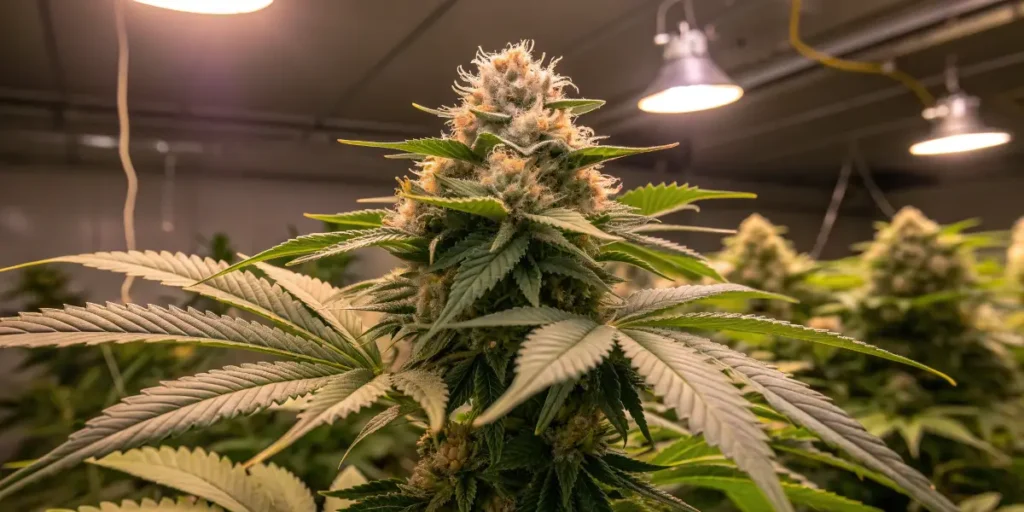
How to Germinate & Propagate Watermelon Auto
Germinating and propagating Watermelon Auto cannabis seeds is the first crucial step toward a bountiful harvest. These autoflowering seeds are favored for their ease of growth and rapid life cycle. Successful germination begins by selecting high-quality seeds from reputable suppliers. To initiate germination, employ the paper towel method, which ensures consistent moisture and optimal oxygen exposure. Start by soaking the seeds in a cup of distilled water for around 12–24 hours to kickstart the process. This step hydrates the seeds, promoting the activation of internal enzymes essential for growth.
Once soaked, place the seeds between two damp paper towels, ensuring the towels are moist but not soaking. Position them on a flat surface, such as a plate or tray, and cover with another plate to create a dark, humid environment. Maintain a consistent temperature of around 70–75°F (21–24°C) to optimize germination conditions. Within 24 to 72 hours, you should observe tiny white roots emerging from the seeds. At this stage, the germinated seeds are ready for planting into their preferred growing medium, such as soil or coco coir.
For propagation, gently transfer the sprouted seeds using tweezers to prevent damage. Make a small indentation in the growing medium, approximately half an inch deep, and place each seed root-down before covering lightly. It’s essential to maintain a delicate balance of moisture; the medium should be moist but not waterlogged. Provide ample lighting, essential for growth, once the seedlings have surfaced. Maintaining stable environmental conditions ensures healthy development and reduces the risk of stress-related issues. Regularly monitor the young plants as they develop into robust specimens ready for their vegetative and flowering stages.
Vegetative Stage
The vegetative stage is a crucial period in the life cycle of your Watermelon Auto plants when the foundation for a healthy, productive yield is laid. During this phase, the plants focus on developing strong roots and lush foliage, which are vital for supporting large buds in the flowering stage. This autoflowering strain has a typically shorter vegetative stage, demanding attentive care to maximize its growth potential. Ensuring optimal conditions during this phase will set your plants up for success as they progress to flowering.
Lighting plays a pivotal role in the vegetative growth of Watermelon Auto. Providing your plants with an abundance of light will ensure robust photosynthesis and vigorous development. While autoflowering varieties like this strain can tolerate variable light schedules, maintaining a consistent lighting regimen of 18–24 hours of light per day is ideal during this stage. Make sure your lighting setup is positioned at an appropriate distance to prevent heat stress while still providing adequate intensity, thus promoting healthy foliage expansion without the risk of light burn.
Alongside light, maintaining the right environmental conditions is crucial for vegetative growth. These plants thrive in temperatures ranging from 70–85°F (21–29°C). Additionally, humidity levels should be kept around 40–70%. High humidity ensures that the plants do not dry out excessively quickly, but it is critical to monitor and adjust airflow to prevent mold. Proper humidity and temperature control will prevent stress and foster a conducive environment for cannabinoid production, leading to a more bountiful harvest.
Nutrient management is essential in maximizing the growth potential of Watermelon Auto during the vegetative stage. Since this phase emphasizes foliage and root development, supplying the right balance of nutrients is paramount. A nitrogen-rich fertilizer will encourage leaf expansion, while trace elements such as calcium and magnesium will support strong cellular structure. Be cautious with nutrient concentrations, as autoflowering strains are sensitive to overfeeding. Employing a balanced nutrient schedule will promote vigorous growth and prepare the plants for the demanding flowering phase.
Frequent inspection of your Watermelon Auto plants during the vegetative stage is imperative. Regularly checking for signs of pest infestations or nutrient deficiencies will enable timely interventions, ensuring healthy plant development. Pruning or training techniques, such as low-stress training (LST), can also be employed to maximize light penetration and control height, encouraging a more uniform canopy. By integrating these practices into your care routine, you can enhance the vegetative growth of this cultivar, setting a strong foundation for a gratifying flowering stage.
Flowering Watermelon Auto: What to Expect
The flowering phase for Watermelon Auto, a popular autoflowering cannabis strain, is an exciting period where you will witness significant changes in your plants. This stage typically begins around 4 to 6 weeks after planting. During this time, you can expect your plants to transition from vegetative growth to the reproductive phase, marked by the appearance of tiny, white pistils. These pistils are the initial indicators that your plants are commencing the flowering process, and soon, small, dense buds will begin to develop.
Over the course of the flowering period, which usually lasts around 5 to 7 weeks for this strain, you should observe these buds swelling and maturing. The distinctive aroma of watermelon, mixed with subtle hints of citrus, will gradually become more pronounced as the buds develop. This stage is crucial and requires consistent monitoring because the final yield quality greatly depends on the attention given during flowering. It’s essential to ensure the plants receive adequate nutrients, with a focus on phosphorus and potassium, which are vital for bud development.
Light cycles should be maintained appropriately, even though autoflowers are not as reliant on light schedule changes as photoperiod strains. A consistent 18/6 or even a 20/4 light/dark schedule can enhance the growth and yield of Watermelon Auto. Maintaining optimal environmental conditions, such as temperature and humidity, is equally important. An ideal temperature range is between 68°F to 77°F (20°C to 25°C), with humidity levels reducing from 50% at the beginning of flowering to around 40% as harvest approaches.
As you near the end of the flowering stage, typically around week 8 to week 10 post-germination, you’ll notice the pistils turning amber and the trichomes shifting from clear to a milky white before finally becoming amber. This transition in trichome color is a crucial indicator of maturity and is often used to determine the optimal harvest time. For growers seeking a more cerebral high, harvesting when most trichomes are milky is advisable, whereas waiting for more amber trichomes might yield a more relaxing body effect.
Overall, cultivating this cultivar requires careful attention during the flowering stage to maximize yield and ensure a potent final product. With manageable maintenance and an understanding of its unique flowering needs, growers can expect a successful harvest rich with flavorful and aromatic buds. Proper care during this period will reward you with the best attributes Watermelon Auto has to offer, providing an enjoyable growing and consumption experience.
Fertilizers & Nutrient Schedule
Feeding your Watermelon Auto cannabis plants properly is crucial for achieving optimal growth and maximizing your yield. As an autoflowering strain, this variety generally requires a lighter feeding schedule compared to photoperiod strains. This is partly because autoflowering plants grow faster and thus have a shorter lifecycle. Therefore, overfeeding can easily lead to nutrient burn or deficiencies. It’s important to set a balanced nutrient schedule that caters to the specific needs of your plants at each growth stage. Start with a quarter to half the recommended dosage on nutrient packaging, especially when dealing with sensitive autoflowers like this strain.
In the initial stages of growth, including the seedling and early vegetative phase, Watermelon Auto requires nutrients rich in nitrogen. Nitrogen is essential for leafy growth and establishing a strong foundation. You should use a nutrient solution that has a ratio leaning towards higher nitrogen content. This helps your plant build robust foliage, which is crucial for photosynthesis. As your plant transitions from the vegetative to the flowering phase, it will then need a balanced blend of phosphorus and potassium to support bud development and overall plant health.
During the flowering stage, typically around week 4 or 5 of its lifecycle, this cultivar will benefit from a reduction in nitrogen levels and an increase in phosphorus and potassium. This will facilitate the development of large, potent buds. Phosphorus is essential for energy transfer and photosynthetic function, while potassium aids in enzyme activity and the formation of carbohydrates. Additionally, incorporating micronutrients such as calcium, magnesium, and sulfur is crucial in preventing deficiencies that could affect the plant’s growth and final yield.
To enhance nutrient uptake, consider adjusting the pH of your nutrient solution. Consistently maintaining a pH level between 6.0 and 7.0 will help ensure that your Watermelon Auto can absorb nutrients effectively. Monitoring the electrical conductivity (EC) of your nutrient mix can also prevent over- or under-fertilizing. For this strain, an EC range of 1.0 to 1.4 during vegetative growth and 1.2 to 1.6 during flowering is recommended. Regularly flush your plants with clean, pH-adjusted water to prevent salt buildup, which can lead to nutrient lockout and impact the plant’s ability to absorb essential minerals.
Pest and Disease Prevention for Healthy Cannabis Plants
In order to cultivate robust and healthy Watermelon Auto cannabis plants, implementing proactive pest and disease prevention measures is essential. This strain, known for its sweet aroma and high THC content, can be vulnerable to several types of pests and diseases which, if left unchecked, can significantly affect the plant’s growth and yield. Start by maintaining a clean and organized growing environment. Ensure that the growing medium and surroundings are free of debris and stagnant water, as these conditions can harbor pests and promote fungal diseases. Regularly cleaning tools and containers will also help minimize contamination risks.
Proper air circulation and ventilation are crucial in preventing the onset of fungal diseases such as powdery mildew and botrytis. These fungi thrive in humid, poorly ventilated areas. Installing an efficient ventilation system along with fans can help maintain optimal humidity levels and keep the air moving. This will disrupt the environment for many pathogens and pests that prefer stagnant air. Monitoring humidity and temperature with a hygrometer and thermometer will further ensure that conditions remain conducive to healthy plant development, thereby discouraging unwanted infestations.
Integrated pest management (IPM) is a holistic approach that combines various strategies to control pests effectively. Regularly inspect your plants for signs of spider mites, aphids, and fungus gnats. Introducing beneficial insects like ladybugs and predatory mites can help control pest populations naturally. Additionally, using organic pesticides such as neem oil can provide an added layer of protection without harming the plants. Always follow dosage recommendations carefully to avoid any phytotoxic effects on your cannabis crop.
Maintaining healthy plant nutrition can often be the best defense against pests and diseases. Providing your Watermelon Auto with the right balance of nutrients will enhance its natural resilience and immune system. Avoid over-fertilizing, as excess nutrients can lead to nutrient burn, making the plants more susceptible to infections. Regularly flush the growing medium to prevent salt build-up and ensure the roots have a healthy environment to absorb nutrients effectively. By taking these steps, you’ll create a thriving environment where this cultivar can grow and flourish, free from the threats of pests and diseases.
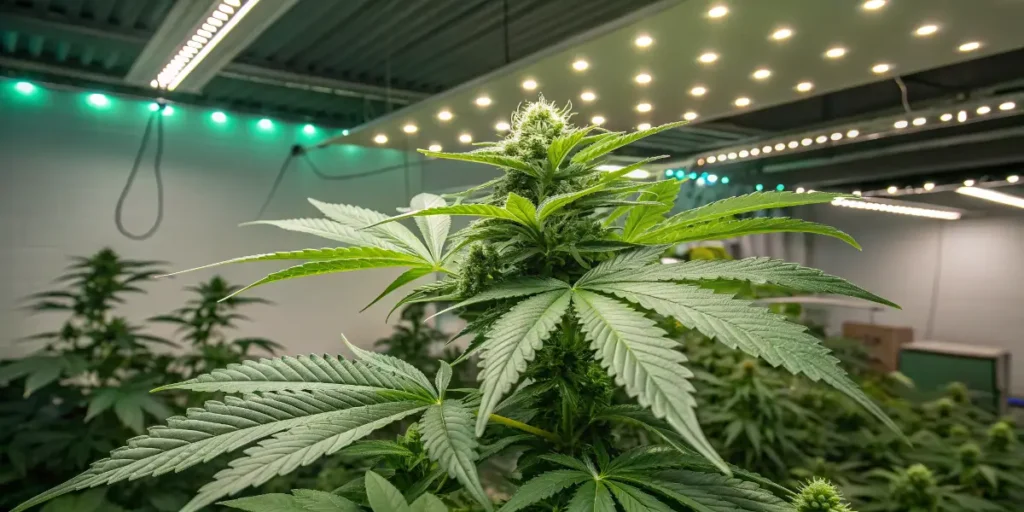
Harvesting & Drying the Right Way
Harvesting Watermelon Auto at the optimal time is crucial to maximize potency and flavor. It’s essential to observe the trichomes microscopic resin glands abundant on buds as they shift in color from clear to milky white or amber, which indicates peak ripeness. The general timeline for harvesting this strain, an autoflowering variety, is about 8 to 10 weeks from seed. However, environmental factors like light, temperature, and nutrition can slightly alter this timeline. Be patient and practice regular observation as you approach the harvest window.
When it’s time to harvest, begin by cutting down the whole plant at the base, preferably in the early morning when terpene levels are at their highest. Handle the plants with care to avoid damaging the valuable trichomes. Trim large fan leaves first to reduce moisture content, making the drying process more efficient. Keeping the trimming clean and precise contributes to the pleasant appearance of the final product. Use sharp scissors or a pruning knife for the best results.
Drying is the next critical step after harvesting your Watermelon Auto. Hang the branches upside down in a controlled environment where temperature and humidity can be regulated. Ideally, maintain a temperature between 60–70°F (15–21°C) and humidity around 50–60%. Proper air circulation prevents mold, while darkness helps preserve cannabinoid and terpene integrity. The drying process should ideally span 7–14 days depending on your conditions. Check the branches; once they snap rather than bend, it’s usually time to proceed to the curing phase.
Properly drying this cultivar reduces chlorophyll, enhancing the bud’s aroma and flavor. During this process, monitor for any signs of mold or over-drying, and adjust environmental conditions accordingly. Patience and precision during the drying phase ensure a quality smoking experience. After drying, the next step is curing, where the remaining moisture is evenly distributed across the plant material, improving both the smoking quality and the shelf life of your Watermelon Auto harvest.
watermelon auto Strain Type: Indica, Sativa or Hybrid?
Watermelon Auto is a fascinating cannabis strain appreciated for its unique genetic composition and characteristics. As a hybrid strain, this variety is a product of the crossbreeding of both Indica- and Sativa-dominant genetics, incorporating the best traits from each lineage. This meticulous crossbreeding results in a balanced hybrid that provides a harmonious blend of effects and benefits, catering to a wide range of preferences among cannabis consumers. Unlike pure Indica or Sativa strains that dominate one set of effects, hybrids are ideal for those seeking a nuanced experience.
The Indica parentage within Watermelon Auto primarily influences the plant’s physical growth and the soothing body effects it imparts. Indica strains are known for their shorter stature, bushier growth patterns, and broader leaves characteristics that are often carried over to hybrid variants. These attributes make this strain a suitable choice for growers with limited space. Moreover, the Indica-derived relaxation and calming effects offer users an experience that can assist with unwinding at the end of the day or achieving restful sleep, making it a popular choice among those seeking relief from stress or insomnia.
On the other hand, the Sativa component in Watermelon Auto contributes to a more uplifting cerebral effect, ideal for users looking for a psychological boost. Sativa strains are traditionally associated with energy, creativity, and focus. Although present in a balanced proportion within this cultivar, these qualities can invigorate users, making the strain versatile enough for daytime use as well. This duality of effects both energizing and soothing makes Watermelon Auto an appealing option for those seeking a balanced experience that reflects traits from both Indica and Sativa origins.
The balanced nature of this hybrid not only affects its consumption experience but also its cultivation. This genetic blend results in a straightforward growth process desirable for both novice and experienced cultivators. The autoflowering characteristic inherited from its lineage accelerates the growth cycle, allowing for faster harvests without the need for specific light changes. The hybrid vigor often translates into robust plant health, offering resistance to common pests and molds, thus maximizing yield potential. The resulting adaptability makes Watermelon Auto a versatile and rewarding choice for growers. Overall, its hybrid nature reflects a perfect synergy of Indica and Sativa traits, making it an esteemed strain for a multitude of uses and preferences.
Key Benefits for Cultivators
Watermelon Auto is a sought-after strain prized for its unique blend of enticing flavor, resilience, and ease of cultivation. For cultivators, this autoflowering variety presents a range of advantages, starting with its remarkably rapid growth cycle. Typically, Watermelon Auto completes its lifecycle from seed to harvest in approximately 8 to 10 weeks. This fast turnover can result in multiple harvests per year, enhancing productivity and profitability for growers who aim to maximize their yield within tight timeframes.
Another significant benefit of cultivating this strain is its manageable stature and compact size, making it an excellent choice for growers with limited space. Whether you’re growing indoors with restricted height or outdoors in a discreet garden plot, the plant thrives within small environments without compromising on output. Additionally, its robust autoflowering genetics mean it isn’t dependent on specific light cycles to flower, simplifying the cultivation process and reducing the complexity associated with photoperiod strains.
Beyond its physical characteristics and growth habits, Watermelon Auto stands out for its sensational sensory profile, offering a sweet, fruity aroma that echoes its namesake—watermelon. This distinct terpene profile appeals to a wide array of consumers, enhancing the marketability of the strain. Cultivators find that the quality of aroma and flavor translates into higher demand and better market prices, making it a lucrative addition to their portfolio.
Furthermore, this cultivar is known for its resilience against common pests and diseases, reducing the time and resources needed for plant care and maintenance. Its hardy nature provides peace of mind for both novice and experienced growers alike, as it requires less intervention and oversight. All these attributes combine to position Watermelon Auto as a top choice for cultivators looking for a reliable, high-yielding, and marketable cannabis strain.
Potential Challenges When Growing Watermelon Auto
Watermelon Auto, an autoflowering cannabis strain known for its sweet aroma and fruity flavor, presents several unique challenges to cultivators. One of the primary issues growers may face is managing its nutrient requirements. Autoflowering strains, including this one, often need fewer nutrients compared to photoperiod varieties. Overfeeding can lead to nutrient burn, which can stunt growth and affect yields. It is crucial to start with a nutrient regimen that caters to autoflowers—likely a diluted mix—and adjust accordingly based on the plant’s response.
Another challenge is the lighting schedule. This strain, like other autos, is not dependent on a specific light cycle to flower, but providing sufficient light can impact the overall yield and potency. Unlike photoperiod plants, which require a shift to 12 hours of darkness to initiate flowering, Watermelon Auto will flower under a range of lighting schedules. Nonetheless, many growers find that a consistent 18/6 light/dark schedule strikes an optimal balance between plant health and electrical cost. Inadequate lighting can lead to underdeveloped plants and diminished returns.
Height management can also present difficulties, as Watermelon Auto has a compact stature that can benefit from certain training techniques. Low-stress training (LST) can help maximize yields by encouraging a more uniform canopy and better light penetration. However, more aggressive methods like topping or high-stress training (HST) are generally not recommended due to the plant’s shorter lifecycle. These methods can cause unnecessary stress and potentially reduce the final yield due to limited recovery time before flowering begins.
Finally, pest control is a common challenge in any grow operation, including with this variety. Common pests such as spider mites, aphids, and whiteflies can quickly become problematic if not addressed promptly. Autoflowers, with their speedy lifecycle, can be particularly vulnerable since there is less time to recover from pest damage. Implementing preventative measures such as regular inspections, using organic pest control methods, and maintaining an ideal growing environment can mitigate these issues and help ensure a healthy, productive garden.
Is Watermelon Auto Worth Buying? Here’s What You Need to Know
Watermelon Auto is an autoflowering cannabis strain that has been gaining popularity among cultivators for its unique attributes and benefits. One of the main perks of this strain is its ability to thrive in diverse growing conditions, making it an excellent choice for both novice and experienced growers. Its genetic composition, primarily a combination of watermelon and ruderalis genetics, ensures a robust growing performance, leading to a rewarding harvest with minimal fuss.
The primary appeal of Watermelon Auto lies in its fast-growing cycle. Autoflowering varieties typically have a quicker turnaround than photoperiod strains, and this cultivar is no exception. It generally takes about 8 to 10 weeks from seed to harvest, which means multiple crops can be achieved in a single growing season. This rapid growth is a significant advantage for those looking to maximize yield in a limited time frame. Moreover, the strain is known for its moderate to high THC levels, providing a satisfactory end product for users.
Additionally, Watermelon Auto is celebrated for its delectable flavor profile, reminiscent of sweet watermelon with subtle hints of citrus and berry. This makes it particularly appealing to consumers seeking a pleasant smoking or vaping experience. The aromatic delight is complemented by a balanced and mellow high, making it suitable for both recreational and medicinal use. Those using it for therapeutic purposes often report relief from stress and anxiety, highlighting its versatile application.
When it comes to cultivation, this variety is relatively low maintenance, requiring standard care routines such as consistent watering and appropriate lighting. Its natural resistance to pests and diseases further accentuates its suitability for growers with limited experience or resources. In terms of yield, cultivators can expect a decent output, with results ranging from moderate to high depending on the growing conditions and care provided.
For those debating whether Watermelon Auto is worth the investment, the answer largely depends on your growing goals and preferences. Its rapid growth cycle, ease of maintenance, and delightful flavor make it a desirable choice, especially for those seeking a straightforward growing experience without sacrificing quality or yield. As market demand for unique and flavorful strains increases, this strain stands out as a valuable addition to any grower’s repertoire. However, potential cultivators should consider their specific needs and environment to determine if it aligns with their cultivation objectives.
FAQs
What is Watermelon Auto?
Watermelon Auto is a term often used to refer to an autoflowering variety of the cannabis strain Watermelon. Autoflowering strains are known for blooming automatically without the need for a specific light cycle, making them easier to grow for beginners. The Watermelon strain, in particular, is popular for its juicy flavor profile reminiscent of watermelons, making it appealing in both taste and aroma. The autoflowering version maintains these characteristics with the added benefit of a shorter growth cycle.
How is Watermelon Auto different from traditional cannabis strains?
Compared to photoperiod cannabis strains, Watermelon Auto does not require specific light schedules to transition from the vegetative stage to the flowering stage. This means it can flourish in varying light conditions, making it more versatile for growers who cannot control light exposure strictly. Additionally, Watermelon Auto typically has faster life cycles, allowing for quicker harvests, and is often more resilient to pests and diseases.
What are the typical effects of the Watermelon Auto strain?
The Watermelon Auto strain usually induces a calming and euphoric high that is popular among consumers seeking relaxation without being overly sedated. Users often report a mild body buzz combined with heightened senses and an uplifted mood. These effects make it suitable for social settings or creative endeavors. Medical users may also seek this strain for its potential relief from stress and anxiety, given its typically balanced THC and CBD content.
What are the best growing conditions for Watermelon Auto?
Watermelon Auto thrives in a variety of climates but will perform optimally in environments where it receives consistent light and warmth. These plants are particularly well-suited for indoor cultivation due to their compact size and minimal light requirements. Though robust and adaptable, maintaining a stable pH in the growing medium and regular feeding with nutrients designed for autoflowering strains can significantly enhance yield and quality. Outdoors, it can be grown in temperate climates as long as there is no risk of frost.
Is Watermelon Auto suitable for beginners?
Yes, Watermelon Auto is well-suited for novice growers due to its hardy nature and simplified requirements compared to photoperiod strains. Its ability to flower independently of light cycles makes it less complex to cultivate, allowing beginners to focus on learning the basics of cannabis growing without worrying about managing light schedules. Moreover, its short growth cycle and resistance to many pests and diseases further lower the barrier to entry for new cultivators.

